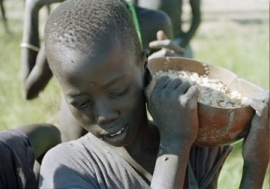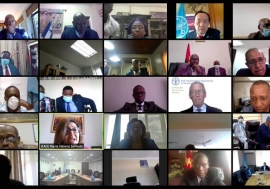Africa struggles with soaring food prices
Africa struggles with soaring food prices
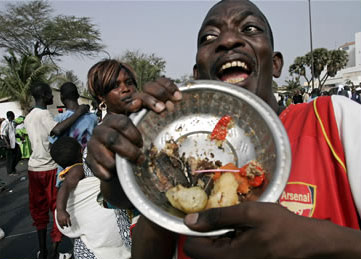 Only when “those excluded from the banquets of the rich took to the streets” did the world take notice, observed Food and Agriculture Organization Director-General Jacques Diouf.
Only when “those excluded from the banquets of the rich took to the streets” did the world take notice, observed Food and Agriculture Organization Director-General Jacques Diouf.The protests against soaring food prices that swept dozens of countries around the world earlier this year have shaken governments and international aid agencies. They have also prompted a flurry of activity to lower the cost of basic staples and expand farm production.
Addressing an emergency summit on the global food crisis in Rome in June, UN Secretary-General Ban Ki-moon underscored the threat to political stability and development. “Nothing is more degrading than hunger, especially when man-made. It breeds anger, social disintegration, ill health and economic decline,” he told world leaders. “Only by acting together, in partnership, can we overcome this crisis, today and for tomorrow. Hundreds of millions of the world’s people expect no less.”
Amid signs that prices for some foods have begun to drop, and with billions of dollars pouring into humanitarian agencies for food aid, seeds and fertilizer, fears of famine in the poorest countries are easing. But the UN’s Food and Agriculture Organization (FAO) has warned that a combination of high oil prices, increased consumption, climate change and growing use of agricultural produce for fuel may mean that the era of cheap global grain supplies is over for good. Unless the world reverses decades of neglect of small-scale farming in African and other developing countries and transforms the way food is grown, harvested and sold, FAO cautions, the current crisis could become permanent and future generations will be hungrier — and angrier — than those of the past.
Skyrocketing prices
The price rises have been most pronounced with the cereal crops — maize, wheat, rice, sorghum and millet — that comprise the basic diet of billions of people. They have also hit feed for cattle, chickens and other meat-producing animals. The price of wheat on world markets rose 130 per cent between March 2007 and March 2008, while rice increased by nearly 90 per cent and maize by nearly a third during that period. Prices for other foodstuffs, including vegetable oil, which went up by 97 per cent, and dairy products, which went up by 58 per cent, have kept pace.
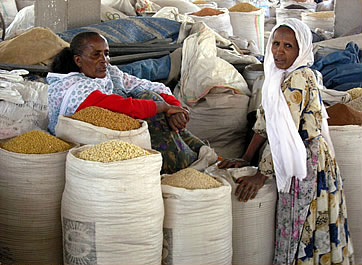 Grain prices have risen sharply in Africa, hitting the poor especially hard since they must spend a large portion of their incomes on staple foods.
Grain prices have risen sharply in Africa, hitting the poor especially hard since they must spend a large portion of their incomes on staple foods.The FAO reports that its overall price index for basic foods, which increased 8 per cent during 2005–06, rose by 24 per cent in 2007. During the first three months of 2008 they were a staggering 53 per cent higher than in the same period the year before.
The price hikes have fallen hardest on the poor in the 82 nations designated by the United Nations as low-income food deficit countries (LIFDCs). Forty-two of those are in Africa. Many of these countries already suffer high rates of hunger and malnutrition and rely on imported food even in good times. Their governments can do little to cushion their citizens from price shocks, lacking funds for subsidies or emergency feeding programmes.
Since food costs typically absorb half or more of family incomes in such countries, many urban dwellers and the poorest farming families have little choice but to switch to cheaper, less nourishing foods, or to skip meals altogether. Consumers in many parts of Africa have started turning to locally grown foods as import prices rise. But even local produce has gotten more costly — in part because of surging fuel costs for transport and processing, but also because of limited supplies and increased demand.
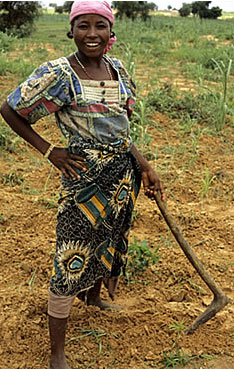 Farmer in Niger: The only long-term solution to high food prices is to help rural Africans grow more food.
Farmer in Niger: The only long-term solution to high food prices is to help rural Africans grow more food.With African agriculture hampered by declining productivity, rising population and low levels of investment (see Africa Renewal, July 2006), the region has little choice but to continue importing food. The UN reports that the total cereal import bill of African LIFDCs rose by more than half in 2007, an increase of more than $7 bn. The burden for 2008 is expected to be even greater, with cereal prices for Africa’s most import-dependent countries expected to increase by 74 per cent, to about double what those countries paid two years ago.
Economists caution that such increases could add 100 million people to the 850 million around the world who are already chronically malnourished. They can also contribute to balance-of-payments problems and worsen debt in the poorest countries. After posting strong economic growth rates in recent years, Africa could see those gains literally eaten up by higher food costs.
Multiple causes
The factors driving the dramatic increases in food prices over the past two years are numerous and still very much debated. Much of the rise has been blamed on the use of maize and other food crops for brewing ethanol and other biofuels for the transport industry. But it is the combination of biofuel production with many other developments that is pushing up prices, agriculture economist Joachim von Braun, director-general of the International Food Policy Research Institute in Washington, told Africa Renewal. Those factors include:
- Rising oil prices, which ripple throughout the farm economy, affecting transportation, fertilizer and processing costs.
- Improved living standards in China, India and parts of Latin America, leading to increased meat consumption and thus higher demand for grain for animal feed.
- Poor weather in major food exporting countries, including years of drought in the Australian wheat belt and flooding in major US maize- and wheat-producing areas.
- Increased speculation in agricultural commodity markets by large investors. The FAO estimates that commercial investment in farm commodities has increased more than tenfold to $150 bn in the past four years, inflating food prices as investors turn to agricultural commodities that promise high returns amid sharp downturns in other parts of the troubled world economy.
- Decades of underinvestment and declining yields in agriculture in African and other poor countries, which increases demand for limited world food supplies and limits the world’s ability to produce more.
“None of these factors in isolation would have caused the very high increases we are seeing,” Mr. von Braun said. “Together they are a creating a very risky situation.”
The coming together of these different influences on food production and pricing, and the way they interact by means of the global economy, pose difficult challenges for national and intergovernmental policymakers. Biofuels provide an example. One consequence of the use of food crops for biofuels, beyond the diversion of food from people to cars, Mr. von Braun noted, is that it links world prices for maize and other food to the runaway price of oil. Higher oil prices increase demand for biofuels, forcing consumers in poor countries to bid against energy producers for food crops, thereby driving prices still higher. The UN estimates that 30 per cent of the maize harvested in the US, the world’s largest producer, will go to fuel production in 2008.
“The complex causes of the food and agriculture crisis require an equally complex and comprehensive response,” noted Mr. von Braun. He told the UN Economic and Social Council in May that solving the current crisis will require a mix of short-term policies to make more food available immediately and long-term initiatives to reduce global inequality, reform damaging farm subsidy and trade policies and increase farm production and self-sufficiency in African and other chronically food-deficient areas.
From neglect to action
The FAO cautions, however, that high food prices are likely to continue for at least the next decade, and that the long era of large world food surpluses and cheap exports that began with the Green Revolution in Asia in the 1960s may be over for good. For now at least, there are signs of improvement. Since the beginning of the year more than $18 bn in cash and commodities has been pledged by donors to meet the food crisis, including $500 mn from Saudi Arabia, $5 bn over two years from the US and $1.2 bn in low-interest loans and grants from the World Bank.
The UN’s World Food Programme, the world’s largest food aid agency, announced that it now has the resources to provide additional assistance to 90 million people in the 40 countries hit hardest by the food price rises, mostly in Africa. The new funds will also allow FAO to expand its pilot $17 mn Initiative on Soaring Food Prices. Originally targeted to provide fertilizer, farm implements and improved seeds to family farmers in Burkina Faso, Mauritania, Mozambique and Senegal, the initiative will expand to another 40 countries that have requested assistance. The UN’s response will be directed by the High Level Task Force on the Global Food Crisis, which was launched by Secretary-General Ban in May.
On the ground, African governments have attempted to reduce prices for basic foods in a number of ways, depending on local circumstances and their own resources. In Senegal, which relies on imports for half of the cereals it consumes, the government announced subsidies of 40 per cent on wheat flour, suspended food tariffs and imposed some price controls. Liberia and Côte d’Ivoire have also waived duties on imported staples. In Ethiopia, where drought is already threatening widespread hunger, the government has introduced a wide range of emergency programmes. These include suspension of the value-added tax (which falls indirectly on consumers) on grain and flour, new subsidies for wheat and the continuation of emergency rations to 800,000 people in the cities.
In South Africa, a major maize exporter and one of the few large African producers of biofuel, the government has capped the use of maize for ethanol production and expanded cash grants to the most vulnerable. Tanzania has lifted duties on an additional 300,000 tonnes of maize imports and has banned food exports.
Ghana announced a $1 bn aid package for hard-pressed consumers, including lifting levies on food and fuel imports, cancelling taxes on fuel for the fishing fleet and subsidizing fertilizer and other inputs for farmers. Combined with a fourfold increase in energy costs and lost revenue from tax cuts, this initiative “is throwing the budget out of gear,” Ghanaian President John Kufuor told the nation on 22 May. It will reduce available funding for national development programmes. But such new spending is necessary, he said, to expand food production and protect the living standards of the most vulnerable.
Economists have criticized the imposition of export bans by major suppliers, particularly rice exporters, to protect local consumers, arguing that export controls only further restrict global supplies and drive prices higher. Price controls have also come under fire because, experts say, they are difficult to enforce, encourage the development of black markets and reduce price incentives for local farmers to grow more.
With fears of famine and street protests easing and prices for rice and some other commodities on the decline, export controls are being lifted in some countries and the focus is turning to what everyone agrees is the long-term solution to the price crisis — increasing production and food security in the poorest and hungriest nations.
Disaster foretold
The fury in the streets over the food crisis may have succeeded in prodding the world into emergency action. But only time will tell whether the demonstrators have shocked their leaders into finally tackling the crisis in global agriculture. Addressing the Rome summit, FAO Director-General Jacques Diouf reminded the assembled heads of state and government that they had been at this point before, in 1996 and again in 2002, promising both times to end world hunger.
“The facts speak for themselves,” Mr. Diouf said. “From 1980 to 2005 aid to agriculture fell from $8 bn . . . to $3.4 bn.… Agriculture’s share of official development assistance fell from 17 per cent in 1980 to 3 per cent in 2006.” This was despite the fact that farming provides the sole livelihood for 70 per cent of the world’s poor. The sometimes violent protests that erupted around the world in recent months, he said, were “but the chronicle of disaster foretold.”
Africa, Mr. Diouf noted, has made efforts to reverse the decline in agriculture. Its leaders adopted the New Partnership for Africa’s Development (NEPAD) in 2001, and within two years had drafted a detailed and comprehensive agriculture plan to restore depleted soils, increase harvests and lift millions out of poverty. Some 50 African countries, he continued, developed national agriculture reform programmes in conjunction with FAO, actions also taken by governments in poor countries elsewhere in the world.
African leaders meeting under the auspices of the African Union in Maputo, Mozambique, in 2003 also pledged to devote at least 10 per cent of their national budgets to agriculture and rural development by the end of 2008, as well as to rebuild domestic grain stocks and cooperate with farmers’ and other civil society groups on agricultural policy. The African Union reported in June 2008 that domestic investment in agriculture has increased in most countries over the past five years, and that about 10 countries have met or exceeded the 10 per cent spending target.
The increases, often accompanied by changes in government policies to strengthen support for small-scale farming, have produced some encouraging increases in food production. The most dramatic improvements have come in Malawi, where the government disregarded the advice of donors and doubled the country’s maize harvest with a $60 mn fertilizer-and-seeds subsidy programme for smallholders in 2006. The government also erected 600 improved locally manufactured maize storage silos over the past year to reduce losses to rot and pests.
In Kenya a $5 mn international loan guarantee programme has secured some $50 mn in private-sector loans to family farmers to allow them to purchase improved seeds, fertilizers and other inputs. Over the long term, Kenyan Agriculture Minister William Ruto told the Rome summit, “We believe the most comprehensive way to deal with high food prices, hunger and poverty is to invest in agriculture and raise food production.” Kenya is exploring with other East African governments the feasibility of building a fertilizer factory to meet the region’s growing demand, he said, and strengthen cross-border cooperation in agriculture.
But too often, noted the FAO’s Mr. Diouf, Africa’s development partners have failed to support such efforts. International investment for rural development declined, he said, while subsidies for Northern farmers topped $370 bn per year, arms spending reached $1,200 bn in 2006 and biofuels subsidies diverted 100 mn tonnes of cereals from human consumption into the petrol tanks of the more fortunate.
“It was only when the destitute and those excluded from the banquets of the rich took to the streets to voice their discontent and despair,” Mr. Diouf noted, that the world took notice. “The problem of food security is a political one,” he concluded. “The time for talking is long past. Now is the time for action.”









